home | galleries > pre-columbian > colonial > shipibo > african > asian > classical > pacific rim | restoration services | display stands | about | contact
Pre-Columbian
Welcome to the Pre-Columbian Gallery. Here I will offer quality, yet affordable, authentic artifacts from throughout the Americas.
This gallery will be regularly updated so check back often. Please ask if you
would like additional photos or more in-depth descriptions.
Enjoy your treasure hunt...
NOTE:
All items being offered on this website have appropriate provenance and are legal to buy and own under the United States statute covering cultural patrimony Code 2600, Chapter 14.
Every purchase comes with a written certificate of authenticity (COA) and are fully guaranteed to be as described. Provenance and accurate, detailed condition information is included with each listing.
To Purchase or Ask a Question:
Contact me via email at: joey@ancientartifax.com or call 828-322-2942. Payment options are check, money-order or PayPal. Credit Cards can be processed through PayPal.
Discount may apply on the purchase of multiple items.
Shipping costs are not included in the purchase price. Shipping options are (U.S. only) via USPS Priority Mail, UPS Ground or FedEx. Tracking info will be provided.
Fragile items will be double-boxed.
International Sales: Shipping outside of the United States is no longer available. International shipping has become overly stressful and is no longer an
option due to unpredictable costs, customs issues and import/export restrictions that vary by country.
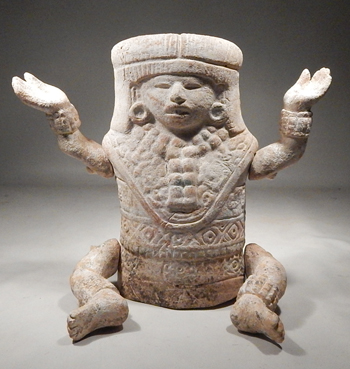 |
 |
Nopiloa Articulated Figure — Vera Cruz, Mexico
600 AD - 900 AD
An exquisitely detailed Nopiloa articulated figure from the Veracruz/Gulf Coast region of Mexico. Veracruz Nopiloa ceramics are known for their fine execution. Examples of these figures are closely related to the Maya figural tradition. This example is beautifully made and highly detailed. It features a white kaolin slip (as is common) and traces of blue pigment. It once had articulated limbs that were lost in antiquity; which is typical for these types. The body is intact and original with a few superficial surface cracks, light staining and deposits on the bottom and root marks present. The arms and legs are modern replacements. Overall in good condition and a lovely example that displays impressively.
Ex. J. Martinez collection of southern California.
Approx. 7" tall x 4" wide.
$950
|
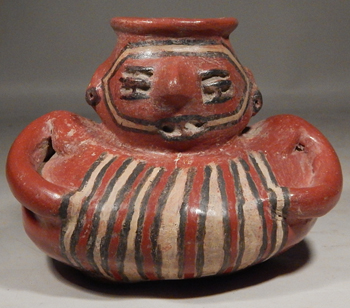 |
 |
Chupicuaro Polychrome Figural Vessel — Mexico
300 BC - 100 BC
An exceptional Chupicuaro Figural Vessel from central Mexico dating to the Late Pre-Classic Period. The bold geometric patterns in red, black, and white are characteristic of Chupicuaro ceramics. The striking linear patterns are continuous on the figure's chest and back. While these painted renditions are traditionally interpreted as textiles, they often cover Chupicuaro figures so completely that body paint may be represented. In good condition. An area on the side of the head and upper rim have been restored along with light paint touch ups; otherwise original and complete. The beautifully burnished surface shows wear, mainly on the bottom. A small, but fine example and a rare type.
Ex. San Francisco, CA private collection, circa 1960s; Ex. Cichon Tribal Arts of Florida.
Approx. 4" across x 3.25" tall.
$450
|
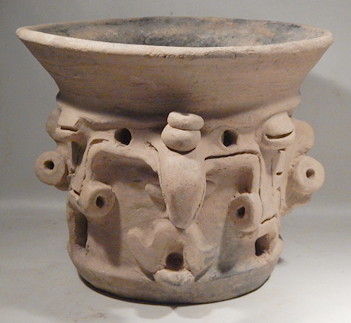 |
 |
Zapotec Tlaloc Brazier — Oaxaca, Mexico
400 BC - 100 BC
An exceptionally rare Zapotec Tlaloc incensario brazier dating to Phase 1. Tlaloc (the Storm, Rain & Lighting God) is technically a Teotihuacan deity, but the very early Zapotec adopted (borrowed) the storm god's features and used them on their vessels and effigies during the Formative Period. This example shows a humanoid head within an avian-like (bird) mouth and beak, worn like a helmet. The Zapotec later developed their own distinctive (seated human) version of Tlaloc known as 'Cocijo'.This brazier is in very good condition. A few small shards missing at the rim have been restored. The interior is blackened and charred from extensive use in ancient times. A fine and seldom seen example from the early Zapotec culture. Ex. M. Clay collection of Virginia.
Approx. 6" tall x 7" across.
$750
|
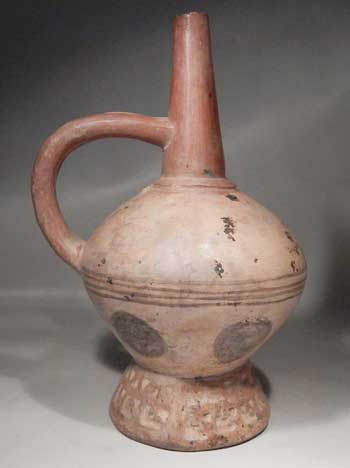 |
 |
Lambayeque Painted & Carved Vessel — Peru
800 AD - 1100 AD
A Lambayeque polychrome painted and carved vessel from the north coast of Peru. The vessel is round-bodied and topped by a tall tapering spout. The wide footed base is carved with
temple step and triangular designs. A conjoined (double-rope) strap handle on the side connects from the body to the lower spout.
The body of the vessel is painted with horizontal stripes at the mid-section; below that are circular (solar) decorations as are commonly seen on single-spout vessels of this type.
Painted overall in a cream slip with red-orange spout and handle along with black-brown painted details.
The vessel is in near excellent condition. Nicely burnished exterior with light deposits, dendrites and scattered root marks present. A few small chips at the
tip of the spout and light paint touch ups; otherwise completely intact and original with no repairs or restoration. The spout chips could be restored upon request.
An attractive piece with graceful form and a classic example of Lambayeque pottery.
Ex. J. Schaeffer estate collection of Florida.
Just under 8" tall x 5" across.
$325
|
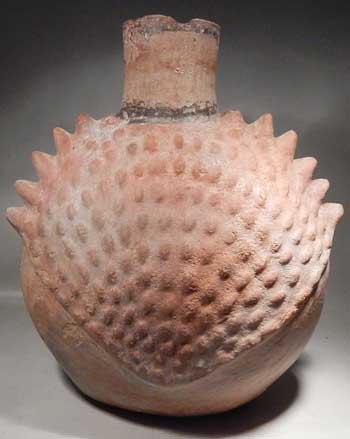 |
 |
Moche Spondylus Shell Vessel — Peru
400 AD - 700 AD
An extra-large Moche spondylus shell pottery vessel from ancient Peru. Spondylus shell was highly valued by many Pre-Columbian cultures, even more than gold
and silver. The spondylus shell (thorny or spiny oyster) was found only in Pacific coastal waters from Panama to Northern Peru and was traded extensively throughout
the Americas. The shell's form was also carved into stone and shown in pottery effigies, as seen here.
Spondylus held important ceremonial and ritual significance; when carved, the shells revealed layers of vibrant colors in white, orange and pink.
Andean cultures used complete spondylus shells in ceremonial rituals and they were also cut into smaller pieces and used in jewelry, inlays, and
as trade currency and placed in burials. This vessel is in as-found (original) condition with light deposits overall.
There are areas of surface erosion, spout chips and a stable crack, but it is intact and unrestored. No repairs at present, but could be restored if desired.
A very rare example showing a realistically sculpted spondylus shell and seldom seen in such a large size.
Ex. J. Schaeffer estate collection of Florida.
Approx. 9" tall x 8" across.
$475
|
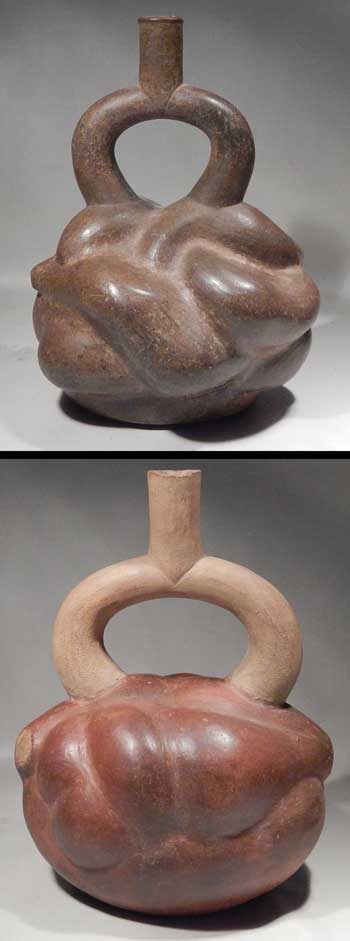 |
 |
Moche 'Yakon' Root Stirrup Vessels — Peru
Two rare and unusual Moche phytomorphic stirrup vessels from ancient Peru. Both depict the Yakon (Yacon) root 'Polymnia sonchifolia'; an edible plant native to the temperate valleys and somewhat higher altitudes of the Andes.
The plant is a relative of the dahlia. It has yellow flowers and twisted (knotted) root structure that is high in sugar and starch. The early Spanish chronicler Bernabe Cobo described the root
as sweet, watery and much like a turnip. The yakon root could also be dried and stored for later consumption. Yakon and other phytomorphic effigy vessels may have been placed in Moche burials as nourishment for the deceased, offering to
lords of the other world or in commemoration of specific occasions. The Moche frequently made pottery effigies in the forms of various edible fruits and vegetables. Among them
were corn, peanuts, yuca, manioc, squash, the tumbo plant, etc. Yakon vessels like these were created over a period of 1500 years; from the early Moche Phase I through the time of the Inca, up to the Colonial Period.
Vessel #1 (top) - A brownware example dating to Phase I, 50 AD - 100 AD. Nicely sculpted with a burnished surface. In excellent condition. Unbroken and with no repairs or restoration.
Some minor surface erosion, light staining and deposits present overall. A fine and early example.
Ex. Drexel University Museum. Philadelphia, PA. A museum inventory code (94.6 27) is written in gold ink on the bottom. Approx. 8" tall x 6" across. $1000
Vessel #2 (bottom) - A bi-chrome example dating to Phase IV, 450AD - 550 AD. Painting in red slip with a cream stirrup handle and lightly burnished surface. In good condition.
Some surface touch-ups and chips missing at the rim of the spout, otherwise intact and unbroken. Some fire clouding present, mainly along to bottom half and base areas.
Ex. J. Velte collection of Philadelphia, PA. Approx. 8" tall x 6" across. $750
See "The Spirit of Ancient Peru - Treasures from the Museo Arqueologico" by Rafael Larco Herrera, Page 55 for a similar example and addition info on this type.
Priced individually or $1600 for both.
|
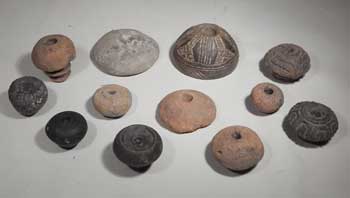 |
 |
Pottery Spindle Whorls — Central & South America
500 BC - 1500 AD
A collection of 12 ancient spindle whorls from various cultures and time periods. Used in the spinning of threads for weaving fabrics, all are
pottery types; some are decorated and some are plain. All are in good condition with surface deposits. A few with chips and wear from use. A nice group.
Ex. R. Murray of Georgia. Sizes range from 0.5" to 1.5" in diameter
$150 for all twelve whorls.
|
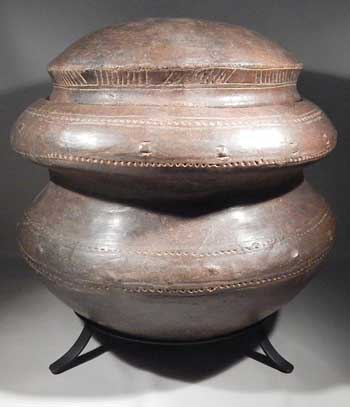 |
 |
San Agustin Urn — Ecuador
600 BC - 100 AD
A very large San Agustin burial urn dating to the late Formative Period. The vessel is globular with a deeply corseted mid-section giving the appearance of two stacked bowls. A domed lid with slightly corseted sides sits atop the vessel. The lid fits well and is very likely original to this piece. Both the vessel and lid are finished in burnished dark chocolate-brown tones. The vessel has rows of punctured (stippled) designs and raised nodes. The lid has linear and angled incised decoration around the rim. In poor condition. The lid has been assembled from around a dozen original pieces; the vessel assembled from several dozen pieces. Break lines are restored but are still somewhat visible. An exceptionally large example and despite considerable restoration, it displays dramatically. Custom metal display stand is included.
Ex. Jack Hart, formally of La Jolla, CA.
Approx 13" tall x 12" across.
$500
|
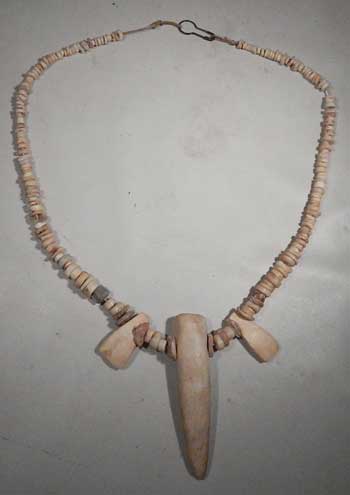 |
 |
Maya Shell & Bone Necklace — Guatemala
250 AD - 900 AD
A lovely Classic Period Maya necklace from the Tikal region of ancient Guatemala. The necklace consist of a long strand of shell/bone beads and three large pendant beads. The beads are shaped into flat spheres, disks and cylindrical forms
of various, graduated sizes with an elongated center pendant and two smaller triangular shaped side pendants. They are strung with sturdy waxed thread and a simple metal hook clasp.
The necklace is currently wearable as jewelry, but if worn often, I would suggest having it professionally restrung. The beads and pendants are in excellent condition, intact and complete. Mineralized deposits,
light staining and very minor surface imperfections are present, as would be expected and are consistent with age. An elegant and attractive example of ancient Maya jewelry.
Ex. M. Dailey collection of Charlotte NC. Prior to that Ex. J. Behnkin estate of Atlanta, GA.
Necklace measures approx. 18" in length. Center pendant is approx. 3" long. Smaller side pendants are just over 1" long.
$475
|
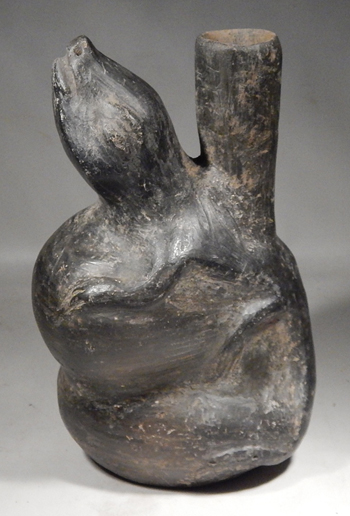 |
 |
Sea Otter Vessel — Peru
1200 AD - 1500 AD
An adorable Sea Otter vessel dating to the late Chimu - Inca period of ancient Peru. The blackware vessel depicts a realistically sculpted sea otter clinging to spherical objects, likely rocks.
A slightly tapered spout emerges from the back of the otter. Unlike the straight spouts of the earlier Chimu, tapered spouts are indicative of the Chimu-Inca transitional period.
The otter is shown with head turned upward, front and rear legs grasp the boulder and the long tail curves gracefully.
Sea otters, aka Sea Cats or 'Gato Marino', are native to the Pacific coast of South America. Typically seen close to shore and in the intertidal areas of northern Peru and south to the coast of Chile and into Argentina.
Marine animals are frequently depicted in the pottery of many South American cultures, but sea otters are very rare.
The vessel is in fair condition. Broken in a shipping mishap, assembled from around a dozen original pieces and break lines restored. Minor erosion to the nose area.
The blackware surface is nicely burnished with earthen deposits present. A cute example and a seldom seen type.
Ex. Tom Oleson of Washington. Acquired by Mr. Oleson while working in Peru for the U.S. State Dept from 1962 to 1963. Later, Ex. G. Dunham collection of Washington.
Just over 7" tall x 4"
$300
|
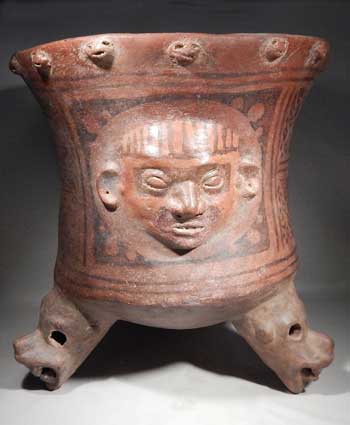 |
 |
Narino Tripod Urn — Colombia
850 AD - 1450 AD
An exceptionally large and extremely rare Narino tripod vessel from the Highlands region, Capuli cultural complex of ancient Colombia. The vessel is round-bottomed with corseted sides
and sits on three large jaguar-head tripod legs, each containing a rattle ball. The urn is decorated with high-relief 'portraits' of two warriors, both with elaborate facial tattooing.
At the rim is a row of small stylized trophy heads. Between the faces are (negative-resist) painted panels with traditional geometric patterns executed in the lost wax technique.
The urn is profusely decorated with classic Narino designs. The jaguar head rattle legs show unmistakable influence of Costa Rican, Nicoya pottery types. It is known that the Narino traveled and traded
with numerous other cultures as far north as the Aztecs of Mexico and with the southern cultures of Peru. The vessel is in fair condition. Reconstructed and repaired, as would be expected with a vessel of this size.
Assembled from approximately 40 to 50 pieces with break lines restored, small losses replaced and paint enhanced. A unique and impressive example that displays dramatically. Ex. Marc Schmitt collection of Indiana.
Approx. 13" tall x 12" across.
$2000
|
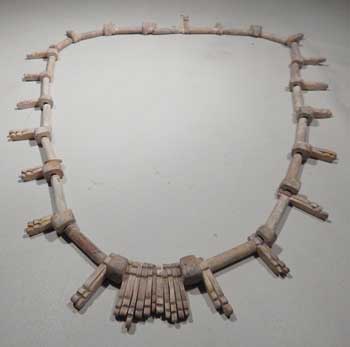 |
 |
Lambayeque Shell Necklace — Peru
750 AD - 1350 AD
A lovely Lambayeque shell necklace from ancient Peru. A long strand of carved shell beads of various shapes. There are tube beads, square beads and elongated
forms with decorative notches at both ends. Currently strung with monofilament (fishing line) and is wearable. Could be restrung and the beads reconfigured into a different arrangment.
In very good, near choice condition. One tube bead is broken and glued. All others are intact and original. The beads are uncleaned and as-found with moderate staining and surface
deposits present overall. A beautiful and nicely crafted example of ancient Peruvian jewelry.
Approx. 28" long.
Ex. J. Behnkin estate collection of Atlanta, GA.
$500
|
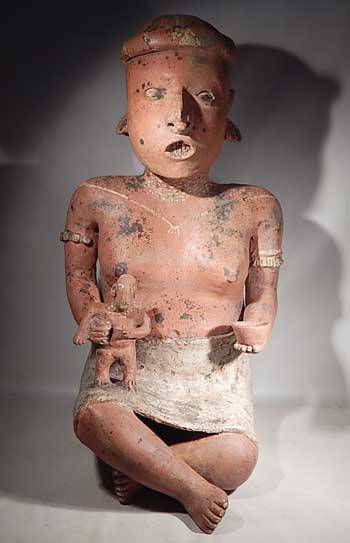 |
 |
Nayarit Artisan Figure — West Mexico
150 BC -150 AD
An extremely large Nayarit seated female figure from ancient West Mexico. A monumental example of the "Ixtlan del Rio" variety.
She sits with legs crossed and is elaborately dressed and highly adorned. Obviously a wealthy individual of high social status. She wears a turban type head wrap, multiple-layered earrings, spherical nose ornament,
arm bands and knee-length skirt. The multi-strand necklace and other torso accents are painted in white. The body and head are covered in a deep orange-red slip along with
cream-white and black. The figure depicts an artist displaying her wares. In one hand, resting on her lap, she holds a human effigy figure wearing ear and nose ornaments.
In the other hand is a small bowl. Figures depicting artisans are exceedingly rare and one of this size is possibly unique. It Illustrates that artists of that time were revered, well paid and highly respected.
In very good condition. Monumental figures are almost never found intact. There are multiple restored breaks along the waist, skirt and upper legs. Small losses have been replaced and several radiating cracks
have been restored. The upper body and head are generally intact and original, as are the arms, effigy figure and bowl. Scattered manganese and other deposits overall. An amazing and rare depiction. She displays impressively!
Ex. Jack Hart collection of Poway, California. Ex. Chris Webster - Webster Enterprises, "The Webster Collection" of Santa Fe, New Mexico. Prior to that, Ex. John Whelan collection.
Approx. 20" tall x 12" across the shoulders.
$5500
|
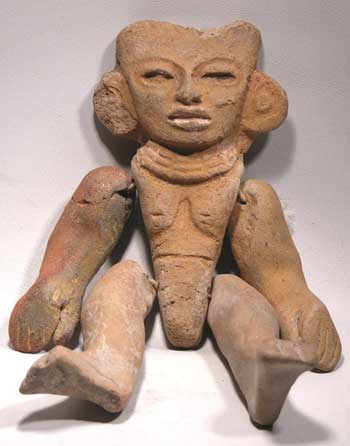 |
 |
Teotihuacan Articulated Figure — Valley of Mexico
400 AD -650 AD
A rare Teotihuacan articulated figure dating to the Early Xololpan Period of ancient central Mexico. Figures of this type, sometimes called 'puppet' figures, have
separately formed (movable) arms and legs tied to the body/head with string. Articulated figures are more common in Teotihuacan art, but were also made by other Mesoamerican
cultures. As is typical of the type and period, the figure is nude with the exception of large ear spools and a wide, beaded necklace. Considerable yellow ocher pigment remaining along with
other deposits. Some fire clouding on one arm.
In fair condition. Glued breaks at the top of the left arm. The top of the head and one ear spool are chipped. The left leg is a modern replacement.
Assembled with modern string. Minor losses and breaks could be restored upon request.
Ex. D. Beecroft collection of Los Angles.
Approx. 5.5" tall.
$500
|
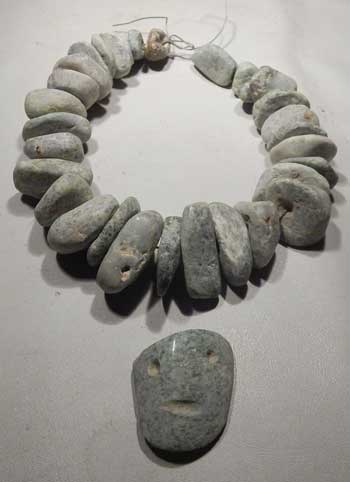 |
 |
Mezcala Stone Beads & Pendant — Guerrero, Mexico
Circa. 500 BC
A fine group of very early Mezcala stone beads and head (mask/face) pendant from the mountainous region of Guerrero in modern-day Mexico.
All show mineralization and calcified surface deposits.
The Mezcala culture is famous for its prolific production of stone jewelry, figural sculpture, animal effigies and architectural models.
Top - A group of 31 beads, fashioned from similar but varying shades of light green stone. All are bi-conically drilled and are in excellent (wearable) condition. The strand totals 11" in length. The beads could be easily re-strung into a necklace or
divided to make bracelets, earrings or pendants. Modern beads could also be added to create stunning, wearable ancient art. The beads generally flatish and circular.
They measure from approximately half an inch to over 1 inch across. $400 for all 31 beads.
Bottom - A nicely polished green-stone head pendant with drilled eyes and groove-cut mouth. The face is highly stylized and abstract as is common for very early Mezcala stone pieces. Bi-conically
drilled at the top and back for suspension as a necklace pendant. Approximately 1.25" x 1". $200
Ex. C. Regueira collection of Florida.
Priced individually, or $500 for the beads and pendant.
|
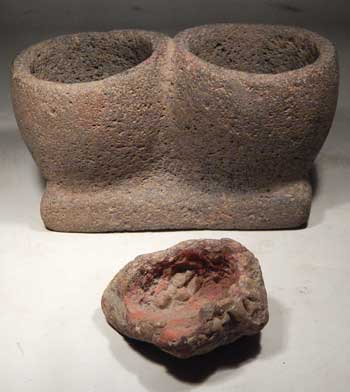 |
 |
Maya Stone Double Mortar — Guatemala
100 BC - 300 AD
A rare and exceptional Maya stone (basalt) double mortar (grinding receptacle) dating from the Proto-Classic to very early Classic Period.
Double (tandem) containers on a single platform are also found in other Mesoamerican cultures and are almost always associated with a sacred use.
Not necessarily ceremonial/ritual, but the materials placed within them were considered precious.
This example was obviously used for grinding pigments. Much of the surface is embedded with traces of red pigment, either cinnabar or hematite. Both cinnabar and
the more easily accessible hematite were used by the Maya for decorating pottery vessels and other sacred items.
In very good, near choice condition. One corner of the base has an ancient chip (loss) otherwise intact.
Surfaces are worn smooth from extended use and handling. Approx. 4.5" x 2.25" x 2.5".
NOTE: Also included is a nodule of hematite ore in its natural state. The type of ore used by the Maya to create red pigment.
Ex. Marc Schmitt of Indiana, Ex. C. Regueira of Florida.
$600
|
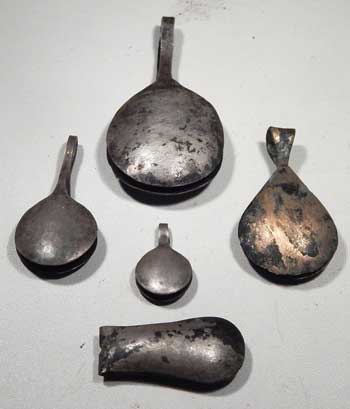 |
 |
Chimu-Inca Tweezers — Peru
1000 AD - 1500 AD
A fine collection of Chimu-Inca metal tweezers from Northern Peru. Four are silver and one is tumbaga (gold/copper alloy).
These tweezers (depilatory tools) were used by the men (and likely women as well) to remove facial and body hair. Grooming implements like these were used by many ancient American cultures,
long before the introduction of razors. All are in very good, near choice condition;
intact and useable. One (at the left) has two small dents on one side. The largest has a tiny split (crack) at the edge. All show light deposits and surface tarnishing
which could be cleaned (polished) if desired. The rectangular example has a small hole at the top for suspension. All are well made and sturdy. They could be placed on necklaces and be wearable as pendants.
Sizes range from the smallest at 3/4" long to the largest at 2" long.
The large example is Ex. J. Behnkin estate of Atlanta, GA. The other four are Ex. Brian Cullity collection of Massachusetts.
$475 for the group of five.
|
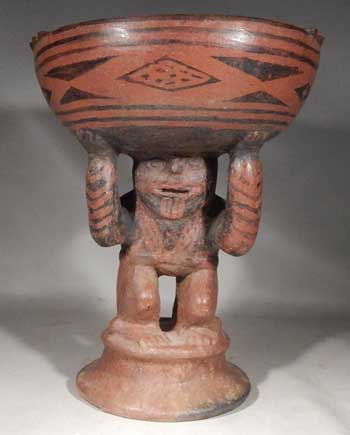 |
 |
Narino Figural Vessel — Ecuador/Colombia
750 AD - 1150 AD
A rare Narino figural pedestal bowl (chalice) from the Carchi-Narino region - Capuli cultural complex located at the border of Ecuador and Colombia.
A hand-built pottery sculpture covered in a red slip and painted in black designs done in negative resist.
It shows a standing figure holding a large bowl atop his head and hands; a type is referred to as 'Atlantean Figures'. The figure is that of a coca chewer (coquero).
A bulge in the cheek represents a wad of coca leaves (called a quid) that is being chewed to release its narcotic properties; likely to induce a shamanic trance.
In fair to good condition. The upper bowl and forearms have been assembled from original pieces, break lines restored and paint touched up as needed.
For a similar example see: Labbe, Armand J. "Colombia Before Columbus: Ceramic Art of Prehispanic Colombia." page 140, fig 119.
Ex. Collection of Imer & Nicholas Molbar. Collected between 1960 & 1978.
Approx. 8.25" tall x 6" wide.
$675
|
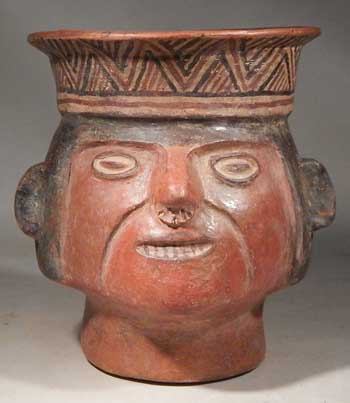 |
 |
Inca Portrait Head Kero — Peru
1400 AD - 1550 AD
An exceedingly rare Inca portrait kero (cup/goblet) from the north coast of Peru. Nicely sculpted and polychrome painted in shades of red, cream white and black.
His face shows a partially open mouth with teeth exposed and wearing a small a nose ornament. The spout and underside of the rim are decorated with linear geometric designs.
Although few of this type are known to exist, it is thought they represent actual people; a ruler, shaman or individual of high social status.
In poor condition. The face, one ear and front spout are original, but the neck, base, back of the head and rear spout area have been replaced and restored to match.
Light surface wear and scattered deposits present. Despite considerable restoration, it is an exceptional example that appears intact and complete.
Ex. V. Hansen collection, FL. Acquired from Michael Cichon Tribal Arts Gallery.
Approx. 4.5" tall x 4" across.
$425
|
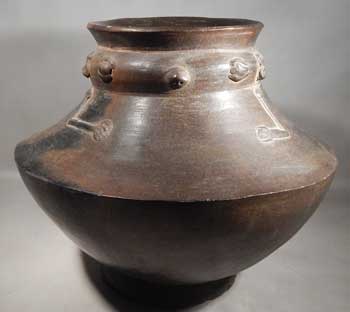 |
 |
San Agustin Figural Vessel — Colombia
600 BC - 100 BC
A large San Agustin figural urn dating to the Horqueta Period. A beautifully crafted, burnished brownware vessel with a lintoid body and footed base. Just below the flared rim is a
highly stylized face and arms resting on the upper shoulder. This simplistic, almost abstract form is typical of the period and are more minimalist than the later Tairona types.
In good condition; restored from several large pieces and a few smaller shards. Minor chips have been replaced; otherwise intact and original.
Light exterior deposits and soil encrustation, mainly on the interior. A striking example that is substantial in size. Ex. D. Marotti collection of Arkansas.
Approx. 9" tall x 10" wide.
$675
|
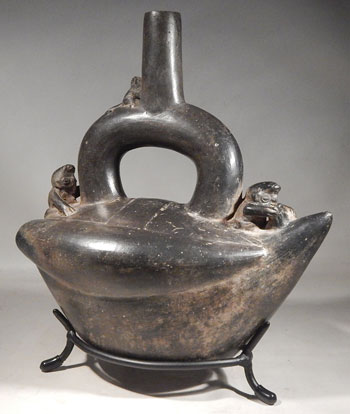 |
 |
Chimu Boat Stirrup Vessel — Peru
1100 AD - 1450 AD
A nice Chimu stirrup vessel from Peru. It depicts two fishermen riding atop a large reed boat. The two oarsmen, one at the prow and one at the stern,
are finely detailed and wear conical hats. Between the figures is a stirrup handle and spout decorated with a monkey adorno.
Along the North Coast of Peru, ancient Chimu fishermen navigated the waters of the Pacific Ocean in reed boats (called 'caballito de totora') to catch fish and hunt marine mammals.
Contemporary fishermen in Peru still use this same type of boat. This beautifully sculpted and highly polished blackware example
is in very good condition. The spout has been replaced (restored) and the monkey's face is chipped, otherwise completely intact and original.
Ample surface deposits present overall. A sizable example that displays well on a custom metal stand (included). Museum deaccession with an inventory number
written in gold ink on the bottom. Ex. Drexel University Museum of Natural Sciences, Philadelphia, PA. Later, Ex. T. Block collection of Ohio and R. Regimbal collection of California.
Approx. 8.75" tall x 7.75" long. Approx. 9.5" tall on the stand,
$475
|
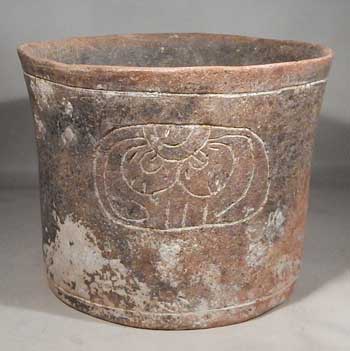 |
 |
Peten Maya Cylinder Vessel — Mexico
600 AD - 900 AD
A classic period Maya cylinder vessel from the Peten region of the Northern Yucatan Peninsula. On each side is an incised glyph of the word 'Ja-yi' —
a regional variation of the Ja-yi glyph, pronounced Jay (Hay) which translates to 'thin-walled vessel'. This single glyph, or
in combination with other glyphs, has been seen on vessels from many Maya regions and was used to signify well made (thin walled) pottery. An
artisan boasting (bragging) of their superior artistic achievement and/or high-quality workmanship. Constructed of orange terracotta with darkened areas
of fire clouding. Some white stucco remaining with traces of red pigment inside the glyphs. In poor condition. Assembled from approx. 12 to 15 original pieces with rim
losses replaced and break lines restored. Ample deposits overall along with scattered root marks. Ex. S. Tyson collection of Florida.
Approx. 5" tall x 6.5" across.
$475
|
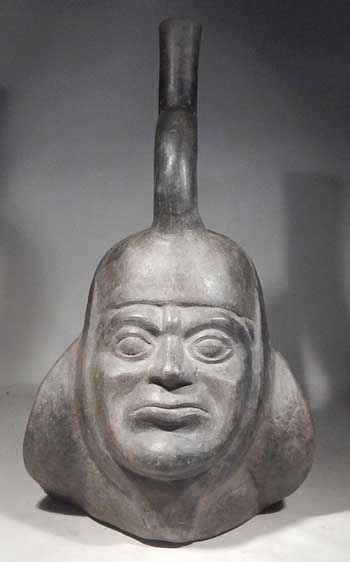 |
 |
Moche Blackware Portrait Vessel — Peru
450 AD - 550 AD
A rare Moche blackware portrait vessel from ancient Peru. It depicts an important Moche dignitary with a serene expression.
The vessel is topped by a stirrup handle and straight (Phase IV) spout. Moche portraiture reached its pinnacle during Phase IV as artists'
demonstrated an extraordinary ability to capture the subject's likeness and provide a sense of individual personality. Previous Phases (I-III)
produced mostly generic heads and not portraits of specific people. Oddly, the trend of true portraiture that was prevalent in Phase IV did not continue into Phase V.
The Moche suddenly stopped producing realistic portraiture by the end of Phase IV and by Phase V only generic heads were made.
This blackware example is quite unusual as the vast majority of Moche portrait vessels were decorated with various colored slips; very few were made as black or gray wares.
Blackwares were the result of modified firing technique called 'smudge firing'. Once the kiln reached peak temperature the potters added more fuel to the kiln
then quickly buried the kiln under sand. The newly added fuel produced intense smoke which was trapped by the sand driving carbon deep (or completely) into the walls of the pottery.
Smudge ware pottery was never painted, but were burnished to a semi-gloss or high gloss finish. In fair condition. Broken and reassembled from approximately 15 original
pieces with restored break lines, but appears intact and displays well.
Ex. Sandra Iona collection of Florida.
Approx. 11" tall x 6" across.
$975
|
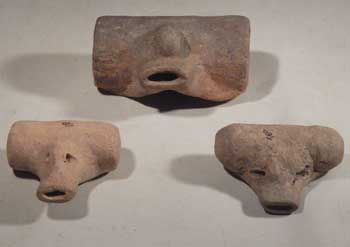 |
 |
Teotihuacan Whistle Pendants — Mexico
250 AD - 700 AD
A trio of Teotihuacan pottery zoomorphic whistle pendants in the form of stylized animal heads. The main chambers are cylindrical with the protruding mouthpieces.
All have suspension loops for wearing as pendants. Each is a functional whistle with holes at the sides to make them playable as two-note musical instruments.
In good condition with small chips and losses restored. Ex. J. Major collection of Chicago, IL. Collected mid 1960s.
Large whistle is approx. 2.75" x 1.75". SOLD
Small whistles approx. 2" x 2" - $80 each, or $150 for both.
|
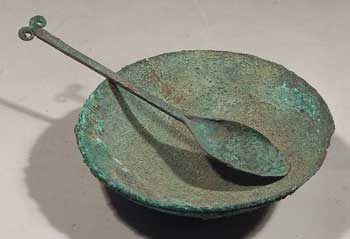 |
 |
Inca Copper Bowl and Spoon — Peru
1300 AD - 1500 AD
An Inca copper bowl and spoon. The spoon has decorative loops on the handle. The bowl is actually two very thin bowls that are fused together.
Both have surfaces covered in green oxidation. In fair condition. The spoon is partially restored on the scoop end. The top bowl has small rim losses; the lower bowl has
an area of loss. Displays well as a set. Ex. M. Dailey collection of North Carolina.
Bowl approx. 3.5" across. The spoon is approx. 4.5" long.
$375 for both.
|
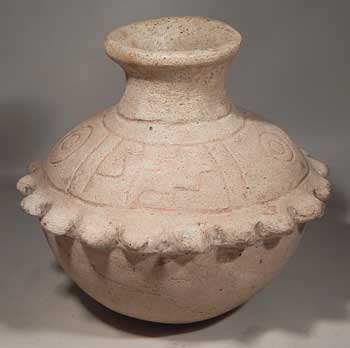 |
 |
Tumaco - La Tolita Olla — Ecuador-Colombia
300 BC - 200 AD
A rara Tumaco - La Tolita pottery olla. White-buff terracotta construction with a row of spiked nodes around the midsection. The upper
shoulder is incised with stepped and circular designs embedded with red pigment. An unusual example.
Nearly all of the ceramics from this culture are figural; vessels are much less common. In very good condition. The rim of the spout is partially
restored along with a small hole on the underside. One node reattached with break line restored otherwise intact and original.
Shows surface deposits and some light staining. A nice ex. museum example.
Ex. Mint Museum of Charlotte, NC. Ex. J. Behnkin estate of Atlanta, GA. Mint Museum inventory code is written on the bottom.
Approx. 5.5" tall x 6" across.
$425
|
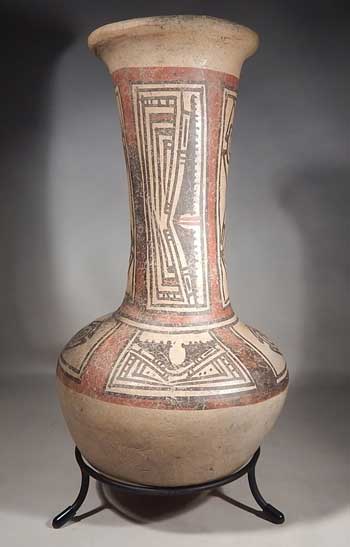 |
 |
Cocle Polychrome Vase — Panama
800 AD - 1000 AD
Large and impressive Cocle polychrome vase from ancient Panama. A tall and beautifully painted vessel done in the Macaracas style; painted with geometric and abstract zoomorphic designs.
Four long panels around the neck and four lower (body) panels that are a continuation of the themes on the neck. Nicely painted overall with mythological motifs in black and orange-red against a cream background.
Two sides depict zoomorphic mythical beings representing stylized saurian heads (alligators), a common theme of this period. The other two sections are abstract mythological designs of highly stylized spiders or crabs.
This design is also sometimes referred to as the 'mystic eye' motif.
The vessel is rounded on the bottom transitioning to a tall neck topped by a flared spout. Condition is very good. A small spout chip and two hairline stress cracks been restored, otherwise completely intact and original.
Moderate to heavy root marks present overall along with other deposits and small areas of light fire clouding. A lovely example.
Displays well on the custom metal tripod ring stand which is included.
Ex. Ken O'Keefe estate of Greenwich CT.
See Labbe's "Guardians of the Life Stream" for additional information on this and other types of Cocle pottery.
Approx. 11.5" tall x 6" across. Just over 12" tall on the stand.
$750
|
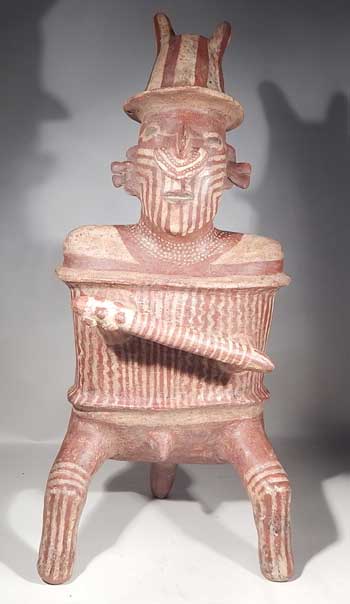 |
 |
Nayarit Warrior — West Mexico
300 BC - 300 AD
A very large and beautifully painted warrior figure from Nayarit, West Mexico. He sits with legs slightly bent and there is a third tripod support leg at the back.
He wields a spiked club with both hands and wears a two-horned helmet. The torso shows protective barrel-type body armor. Nicely adorned with a large triangular nose ornament
and double-lobed ear ornaments. Bichrome painted with intricate patterns in shades of cream against a deep orange-red ground.
The cheeks and lower jaw are covered in wide bands indicating facial tattoos. At the neck is a multi-strand beaded necklace. The body and lower legs are decorated with
linear and wavy striped patterns representing woven armor. An impressive example showing an elongated face, pronounced nose, almond shaped eyes, partially open mouth
and attenuated arms; all classic traits of the Nayarit style. In fair to good condition. Assembled from several large original pieces with
restored breaks across the face, neck and arms with paint touch ups. The burnished surface has light deposits along with minor scrapes and paint loss as would be expected.
Overall an exceptionally large and extensively adorned figure that displays dramatically.
Ex. R. Gill collection of Florida. Ex. Whisnant Gallery, New Orleans, Louisiana.
See Hasso Von Winning's "Shaft Tomb Figures of West Mexico" page 149, fig. 217 for a very similar example and additional scholarly information.
Approx. 16.5" tall x 7.75" across
$2250
|
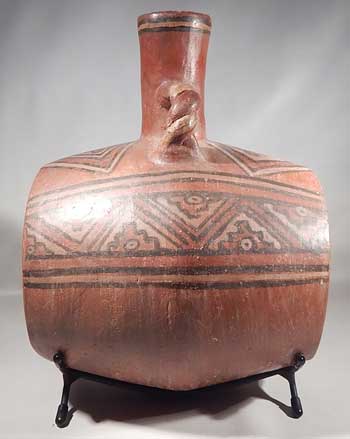 |
 |
Wari Drum Vessel — Peru
500 AD - 800 AD
A rare Wari (Huari) vessel from the Ayacucho region, South-Central Andes of ancient Peru. A cylindrical barrel (or canteen) form vessel, likely representing a drum.
Polychrome painted in cream and black against an orange-red background. The main body shows linear, angular and stepped pyramid designs.
One end is decorated with concentric half-circles; the other end has a row of triangles. The spout is tall and flares slightly with handles that attach to
the upper shoulder. One wide loop handle, the other a twisted rope. The surface is nicely burnished and has deposits along with minor scrapes and dings.
Some pitting and erosion present, mainly on the bottom.
In fair condition. Assembled from around two dozen original pieces with restored break lines. Although restored, it appears near choice and displays well
on the custom metal display stand (included). A very unusual type and large in size.
Ex. A. Leon collection of Florida.
Approx. 10.5" tall x 8" x 7". 11" tall on the stand.
SOLD
|
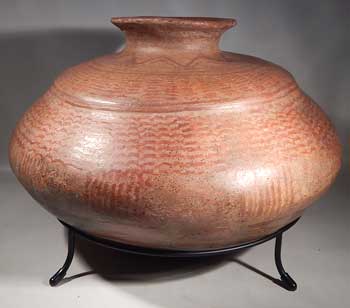 |
 |
Michoacan Olla — West Mexico
200 BC - 200 AD
An extra large Michoacan olla dating to the Late Formative Period of ancient West Mexico. An elegant form with rounded bottom, curving upward to a stepped shoulder and topped by a wide, flared spout.
Intricately painted with undulating linear designs on the upper half and a star design below the spout. The bottom shows 'free-form' brushed designs in groups of three.
In fair condition. Assembled from six large shards and a dozen or so smaller pieces. Minor losses replaced and break lines restored, but appears intact. Some fire clouding on the bottom. An impressive size
that displays dramatically on the custom metal stand that is included. Ex. Adeline Newman estate of Beverly Hills, CA.
Approx. 7.5" tall x 11" across. 8" tall on the stand.
SOLD
|
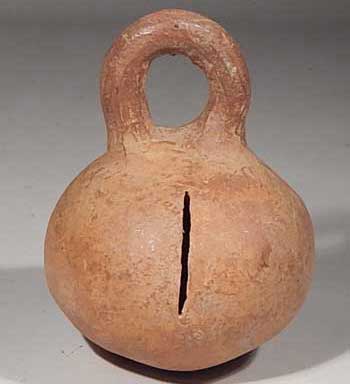 |
 |
Ring Rattle — Costa Rica
100 BC - 500 AD
An unusual 'ring' rattle from the Atlantic Watershed-Central Highlands Zone of ancient Costa Rica, dating to the El Bosque Phase, Period IV.
Finely made with very thin walled construction from orange-buff terracotta with some reddish-brown burnished slip remaining, mostly on the ring handle.
The main body is spherical with two narrow vertical slots and is filled with numerous small rattle balls.
It is thought that rattles of this type were worn on the fingers or as pendants and 'played' during ceremonial events or celebrations.
In fair to good condition. One broken shard has been reattached and small losses replaced. The rattle balls have been replaced as well.
An interesting example and a rarely seen type.
Ex. J. Behnkin estate of Atlanta, GA.
Approx. 2.75" tall x 2.25" across.
$175
|
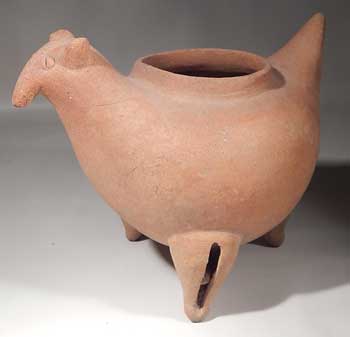 |
 |
Diquis Llama Effigy — Costa Rica
1000 AD - 1550 AD
An adorable llama effigy vessel from Costa Rica - Diquis Zone, dating to Period VI. A finely crafted 'Tarrago Biscuit' pottery example depicting a standing camelid.
Although llamas were not native to Costa Rica, vessels like this suggest that they were certainly aware of their
existence in cultures to the south. The vessel shows a nicely sculpted head and pointy tail. It sits on three slotted legs, two of which still contain the original rattle balls.
In near excellent condition. One ear is slightly eroded, otherwise intact. A rare form and a very cute piece. Ex. A. Schuetz collection of Florida.
See page 220 of "Between Continents-Between Seas, Pre-Columbian Art of Costa Rica" for a nearly identical example.
Approx. 6" tall x 7" long (nose to tail).
$425
|
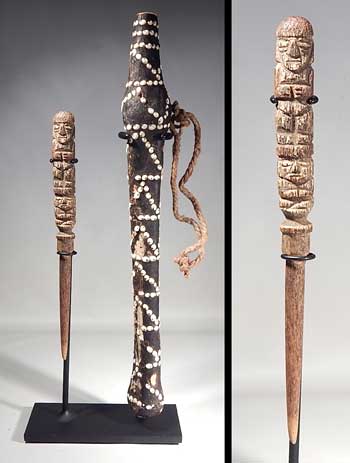 |
 |
Inca Ceremonial Poporo — Peru
1350 AD - 1550 AD
An exceedingly rare and exceptional Inca bone poporo (lime dipper & container). A poporo this large and elaborately decorated would have been ceremonial and
not intended for everyday use. The container is a long bone, probably from a llama, and is covered with animal skin(?) and resin. The resin is embedded with small shells
in geometric linear and triangular patterns. A length of rope is connected to one side. The lime dipper (spatula) is also bone and is nicely
carved with two human figures, the lower figure is seated, the top figure is standing. The dipper fits perfectly into the opening atop the container.
Poporo are lime containers used in the consumption of coca. The coca leaves were ingested by adding a small quantity of powdered lime (ground sea-shells)
and folded into a 'quid'. These coca-lime packets were then chewed. This ritual was typically performed for shamanic purposes as well as to alleviate hunger and altitude sickness.
This example is in very good condition. The container has areas of surface loss and some missing shells, but is generally intact and complete. Comes with a custom
metal display stand. Ex. J. Behnkin estate of Atlanta, GA.
The container with the dipper inserted is approx. 16" tall. Overall display is 13" tall.
$1950
|
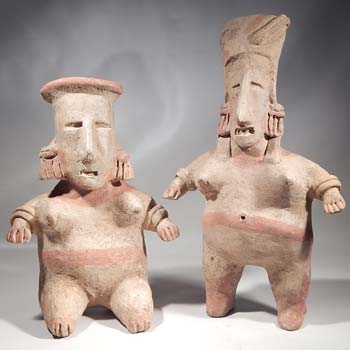 |
 |
Jalisco Female Figures — West Mexico
100 BC - 250 AD
A nice pair of Jalisco female figures. One is seated, the other standing, but stylistically they are nearly identical.
Both are constructed of tan (buff) terracotta with red-orange painted details. Each has a large nose and impressed eyes and mouth.
They wear arm bands, elaborate (tassel-like) ear assemblages and head wraps. Ample deposits present overall. Both in very good condition. The seated figure has an area of fire
clouding on the back and a restored hand. The standing figure has a restored hand and partially restored foot.
Ex. Thomas Pack collection of California. Both are from the same estate collection; they were likely found together and appear to have been made by the same artist.
An exceptionally rare, very closely matching pair of ancient figures.
Seated figure is approx. 7.5" tall. Standing figure is approx. 9.5" tall.
$650 for both. Not for sale individually.
|
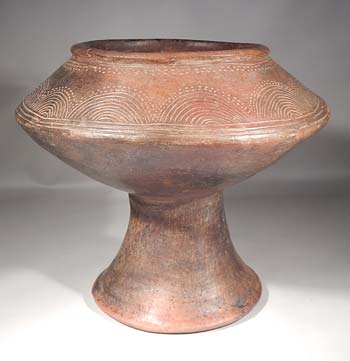 |
 |
Chirique Pedestal Bowl — Costa Rica - Panama
1000 AD - 1500 AD
A lovely pedestal bowl from the border area of Costa Rica and Panama - Diquis Zone, dating to the Chirique Phase, Period VI.
An elegant shape with a flared pedestal base and a sharply angled bowl. The form shows Cocle style influence. The upper shoulder of the bowl is decorated
with finely incised linear and stippled geometric patterns. The burnished surface is a deep orange-red with areas of dark brown fire clouding and light deposits.
In fair condition. The base is intact; the bowl has been assembled from approx. 12 (twelve) original pieces with break lines restored and small losses replaced.
A nice example and a rare type.
Ex. J. Lee collection of New Mexico.
Approx. 7.25" tall x 8" across
$550
|
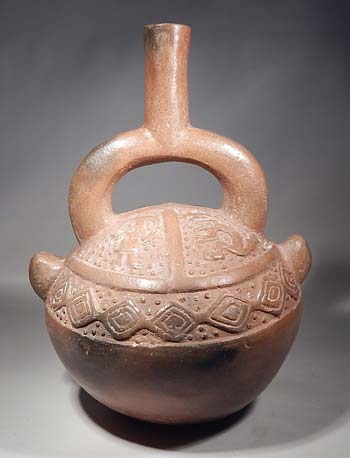 |
 |
Chimu Carved Stirrup Vessel — Peru
1100 AD - 1350 AD
A lovely Chimu stirrup vessel from ancient Peru. Orange-tan pottery construction with nicely burnished surface. The main body is spherical, two large nodes (probably highly stylized birds or bird heads)
protrude from the base of the handle on each side. The stirrup handle is slightly flattened (squared) on the sides and is topped by a straight spout. The upper half of the vessel is intricately carved.
A wide band at the midsection shows a connected diamond pattern. The top section is divided into quadrants each with a central figure. Two human figures with arms held upward and wearing crescent shaped 'solar'
headdresses along with two monkeys (or felines) shown in profile also wearing solar headdresses. The background areas are covered with raised dots, representing rainfall.
In near excellent condition. Intact with no cracks, breaks, repairs or restoration. Light surface wear, deposits overall and some fire clouding present. A fine example that is substantial in size.
Ex. E. Tipton collection of Massachusetts.
Approx. 8.75" tall x 6.25" across.
$550
|
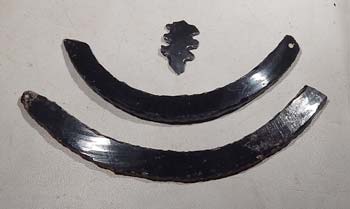 |
 |
Colima Obsidian Pectorals — West Mexico
300 BC - 300 AD
Two partial obsidian pectorals. Nicely knapped from black volcanic glass, these rare and fragile objects were worn as pectorals via two suspension holes.
The two shown here are incomplete; each is missing a portion of one side. Outside of the obvious losses, they are intact with nice deposits.
Priced individually. Buy both and get a free (partial) centipede flint. Ex. J. Behnkin estate of Atlanta, GA. Ex. Mint Museum, Charlotte, NC.
Approx 4.75" across & 5.75" across
$175 each or $300 for both.
|
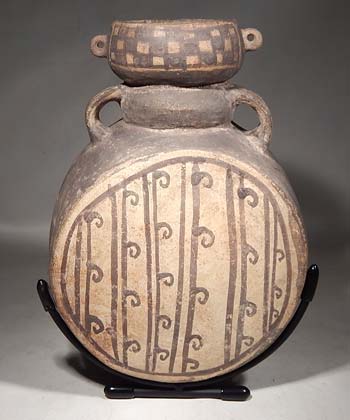 |
 |
Chancay Canteen — Peru
1000 AD - 1400 AD
A nice Chancay canteen from ancient Peru. A barrel-form pottery vessel used for transporting liquids, likely water. An unusual shape with round sides and flat on the front and back.
Both flat panels are painted in vertical lines and waves (water motif). The vessel is topped by a two tiered spout. The lower spout has opposing loop handles that
connect to the upper shoulder of the canteen. The top spout is painted in a checkerboard pattern and has two pierced lugs which would have been used to secure a lid.
Beautifully painted in dark brown-black against a cream ground. In very good condition. Small losses restored on the spout and light paint enhancements, otherwise intact and original.
Some minor paint wear and ample deposits present. A fine example that displays well on the custom metal stand which is included.
Ex. Jeanne Shifres estate of New Haven, CT.
Approx. 7" tall x 5" across.
$450
|
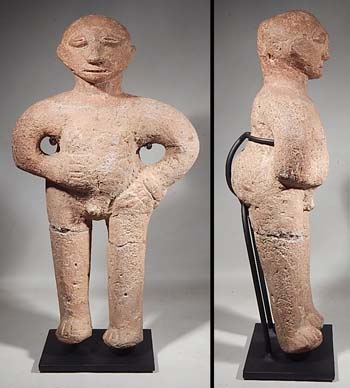 |
 |
Stone Figure — Costa Rica
1000 AD - 1400 AD
Large human effigy figure from Costa Rica's Atlantic Watershed region, carved from tan colored lavastone. It depicts a standing male figure with one hand on the hip, the other at his stomach. The face is nicely detailed with typical coffee-bean style eyes and slit mouth. In fair to good condition. Both legs have been reattachedalong breaks at the upper thighs, otherwise intact and complete. A few scrapes and dings along with surface deposits, but generally a fine example that displays well on the custom metal stand which is included. Leg breaks could be restored for an additional charge. Museum deaccession.
Ex. Mint Museum of Charlotte, NC. Museum inventory code is written on the bottom. Ex. J. Behnken estate of Atlanta, Georgia.
Approx. 11.25" tall. Approx. 12" tall on the stand.
$750
|
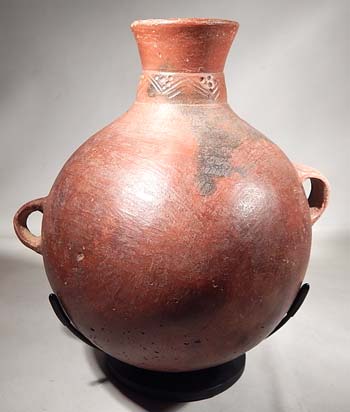 |
 |
Wari (Huari) Aryballos — Peru
700 AD - 1000 AD
A rare Wari aryballo (water transport vessel) from ancient Peru. Redware construction with opposing loop handles and flared spout. At the neck are impressed dots and carved linear geometric decoration. The form is somewhat similar to the later Inca aryballo, but it is unpainted and an unusual shape. The front is rounded (domed) but the reverse is flattened to provide more comfort and stability as the
vessel was carried across the back via a woven trump-line that looped through the handles and across the carrier's forehead. In very good condition. One small handle chip has been restored and there is light pitting, mostly around the bottom and the spout, otherwise intact and original. Areas of fire clouding and ample deposits present. A fine example with a nicely burnished surface. Aryballo vessels are seldom seen from this culture. Custom display stand is included. Ex. Jeanne Shifres Estate of New Haven, CT.
Approx. 9" tall x 8" across.
$600
|
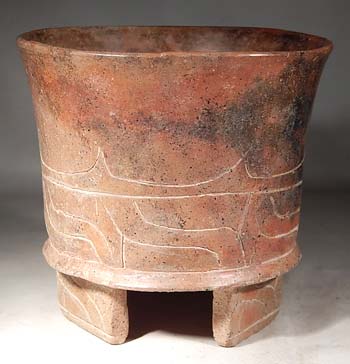 |
 |
Teotihuacan Creamware Tripod Vessel — Mexico
400 AD - 750 AD
A Teotihuacan tripod vessel from ancient Mexico. A cylindrical bowl sits on three solid rectangular legs.
The lower half of the vessel has incised geometric designs known as the 'flame-brow' motif. The design is mirrored on the legs.
The flame-brow design originated on Olmec pottery from approximately 1000 years earlier and has also been seen on Maya vessels of eastern Mesoamerica.
The cream colored surface is nicely burnished inside and out with areas of orange and black (fire clouding) on one side.
In fair to good condition. Assembled from three original pieces with breaks restored. All three feet have been partially restored. Minor surface wear, dings
and scratches along with light deposits consistent with age. An attractive example. Ex. J. Magor collection of Chicago. Originally collected mid-1960s.
Approx. 5.25" across x 4.75" tall.
$475
|
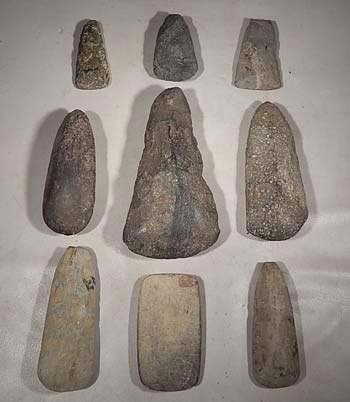 |
 |
Stone Celts & Tools — Costa Rica
800 AD - 1200 AD
A collection of nine (9) stone tools from Costa Rica's Nicoya Zone. All carved from hard-stone of various types and colors. The group contains celt forms, chisels, axes and scrapers.
The colors range from light blue-greens, browns-tans and gray-blacks. In fair to good condition. A few are quite nice and nearly complete. All have chips and losses to some degree.
Several show moderate to heavy edge chipping and losses. All show wear and signs of extensive use.
Each has light to moderate deposits consistent with age. A nice selection of ancient utilitarian stone tools.
Ex. R. Murray of Georgia. Originally collected in the early 1970s.
Sizes range from 2.25" to 5" long.
$350 for all nine. Not sold individually.
|
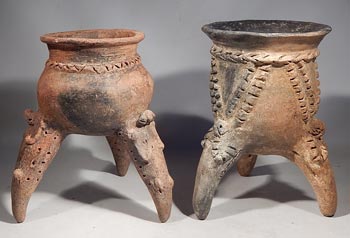 |
 |
Diquis Tripod Vessels — Costa Rica
Two Costa Rican tripod vessels from the Diquis region, circa 300 AD - 700 AD. Both with rows of applied and incised designs. The legs are decorated with stylized zoomorphic figures. The hollow legs contain numerous rattle balls. Ex. R. Murray Collection of Georgia.
Tripod 1 (left) - Orange terracotta with areas of fire clouding. The tips of the legs are restored; otherwise intact. Approx. 6.5" tall x 6" across.
Tripod 2 (right) - Tan (buff) terracotta with some fire clouding. Small rim chip restored; otherwise intact. Approx 6.75" tall x 5" across.
$250 for tripod #1. Tripod #2 is SOLD.
|
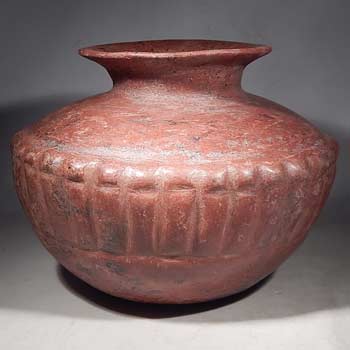 |
 |
Colima Cactus Vessel — West Mexico
100 BC - 250 AD
A medium-large redware phytomorphic vessel from the Colima region of ancient West Mexico. This olla-form vessel is a stylized cactus showing a wide band of raised ribs and nodes sculpted around the midsection.
The bottom is flat. The body is rounded, angles sharply at the shoulder and tapers toward the neck, then flares gently to a wide spout.
The nicely burnished surface is a deep red, typical of Colima pottery from this period. Shows ample manganese and mineral deposits overall, heavy in some areas. Condition is very good.
The outer edge of the spout rim has been restored in several places, otherwise completely intact and original. A fine example.
Ex. G. Conaway collection of Oregon.
Approx 6.25" tall X 8" across.
$625
|
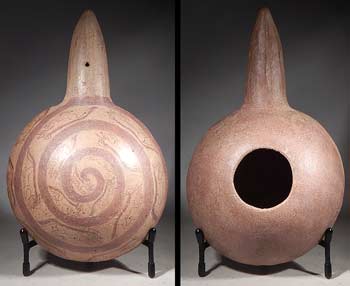 |
 |
Moche Fineline Canchero — Peru
350 AD - 600 AD
A Moche Canchero from Peru. Sometimes referred to as corn-poppers based on their form, they were actually used as ceremonial
water dippers by the ancient Moche. This example is beautifully painted using the fine-line method in shades of red against a tan/cream background.
The painted design depicts a spiraling row of fifteen running foxes. The foxes appear to be playfully chasing one another toward the center.
The handle is a tapered cone that is thought to represent a horn. Condition is fair. Assembled from numerous original pieces with restored break lines and paint touch ups.
Displays nicely on a custom metal display stand which is included. Ex. New Mexico private collection.
Approx. 10" tall x 6" across. Approx. 11" tall on the stand.
$650
|
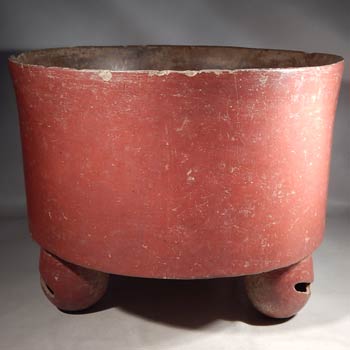 |
 |
Monumental Maya Tripod Cylinder — Guatemala
250 AD - 600 AD
A huge Maya tripod cylinder vessel dating the the Early Classic Period. The elegant form shows strong Teotihuacan influence. The sides are nearly vertical and flare
slightly at the rim. Large, hollow ball-shaped feet are slotted diagonally. The exterior surface is a nicely burnished with a deep orange-red slip.
In exceptional condition for a vessel of this size. One crack in the side wall has been stabilized. There is one smaller hairline crack and several rim chips, otherwise completely and remarkably intact.
Some light surface wear, minor scrapes and dings, all consistent with age. Ample deposits and root marks present. All original with no restoration.
An amazing example and rarely seen in this monumental size.
Ex. Florida private collection.
Approx. 10" tall x 12.5" across.
$2400
|
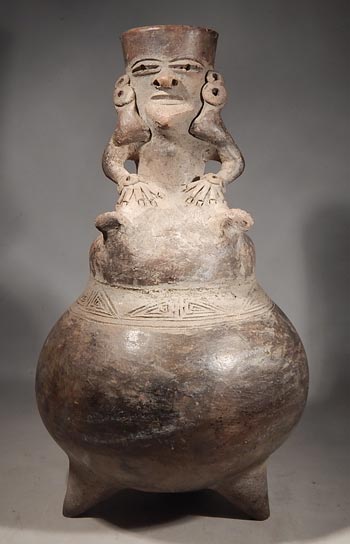 |
 |
Manteno Figural Tripod Vessel — Ecuador
1000 AD - 1500 AD
A large and exceptional Manteno figural tripod vessel from Pre-Columbian Ecuador. Constructed of gray terracotta clay with areas of brown burnished surfacing.
The rounded spherical lower chamber sits on pointy, cone-shaped tripod legs. Around the top of the lower chamber is a band of incised decoration done in a repeating triangular pattern.
Above that is a domed platform topped by a large seated figure with hands resting on his legs. The top of the figures head is open and serves as a pouring spout.
The figure is nicely adorned with elaborate ear spools and bracelets.
His face is expressive with pointed chin and elongated coffee bean eyes. Condition is excellent. Completely intact and original with no repairs or restoration.
Some light surface wear, scrapes and minor imperfections as would be expected. It has never been overly cleaned and still shows ample deposits along with earthen encrustation in the crevices. Overall a great example, quite large and a rare type.
Ex. R. Murray collection of Georgia.
See Klein and Cevallos "Ecuador - The Secret Art of Pre Columbian Ecuador" for additional scholarly information on ancient Manteno art and culture.
Just over 11" tall x 6" across
$1400
|
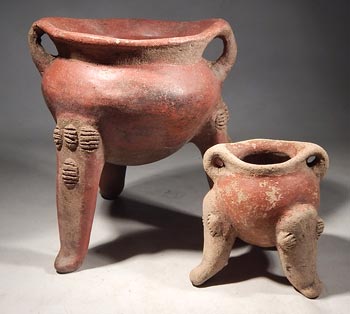 |
 |
Two Tripod Vessels — Costa Rica
300 AD - 700 AD
Tripod vessels from the Atlantic Watershed region of Costa Rica. These are often referred to as Chocolate Pots or Cocoa Cups. Both are of similar construction; buff terracotta partially covered with red burnished slip.
Each has a rounded bowl, loop handles and tripod legs decorated with incised appliques. The legs are solid with no rattles. In good condition. The larger
has some rim repairs and two legs reattached with restored breaks. The smaller tripod is intact with light erosion and paint loss.
Both are ex. R. Murray collection of Georgia.
Larger is approx. 6" tall x 5" across. Smaller is approx. 3.5" x 3".
$300 for both.
|
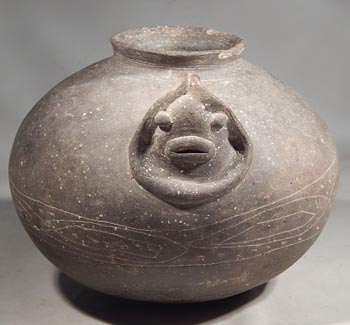 |
 |
Manteno Grayware Olla — Ecuador
1000 AD - 1400 AD
A Manteno grayware pottery vessel from ancient Ecuador. The rounded olla has a flared spout and a head emerging from the side that appears to be a stingray or possibly
a stylized human face. A wide band of incised geometric forms decorate the midsection and up the back. The light gray surface shows moderate deposits
inside and out. In near choice condition with small rim chips, minor scapes and dings otherwise intact and original. Ex. R. Murray collection of Georgia.
Approx. 6" across x 5" tall.
$325
|
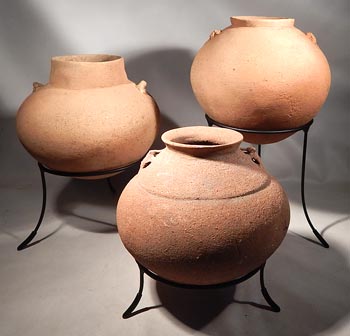 |
 |
Three Tarrago Bisque Ollas — Costa Rica - Panama
1000 AD - 1500 AD
A trio of large Tarrago olla-form vessels from the border area of Costa Rica and Panama (Diquis Zone) dating to the Chirique Phase, Period VI.
Well made and thin walled examples of buff (unpainted) terracotta "bisque ware" pottery, typical of that region. All are round, spherical shapes and are decorated with two small zoomorphic adornos.
The spouts vary in form. In good condition. All have minor restoration, mostly rim chips and small cracks restored, but are generally intact and original.
Light surface deposits present on all three. Each is on a custom metal tripod stand and display beautifully as a group. Stands are 2", 4" & 6" in heights. Ex. R. Murray collection.
Ollas are each approx. 6" in diameter x 5.5" tall.
$200 each or $550 for all three
|
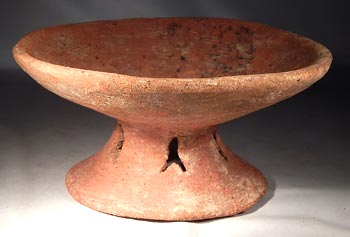 |
 |
Cocle Pedestal Bowl — Panama
600 AD - 800 AD
A Cocle terracotta pedestal bowl from ancient Panama. A flared pedestal base carved with open-work designs supports the upper bowl.
In fair condition. Heavily weathered surface overall with moderate deposits and only traces of painted decoration visible. Several chips along the base, but is otherwise intact with no
repairs or restoration. Ex. R. Murray collection of Georgia.
Approx. 7.5" across x 4" tall.
$175
|
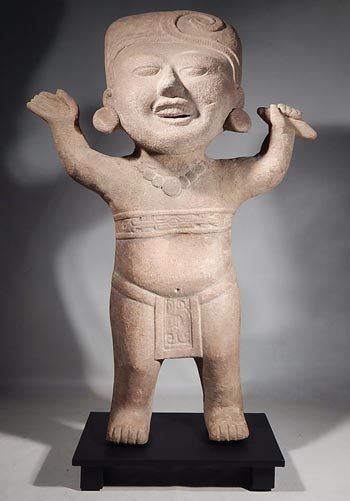 |
 |
Veracruz Sonriente — Mexico
600 AD - 900 AD
A large hollow-molded Sonriente figure from the Gulf Coast, Vera Cruz (Remojadas) region of Mexico. As is typical for this type, it depicts a standing youth with a gleeful expression. Both arms are raised,
one hand holding a small rattle, the other hand is open with what appears to be a 'waving' gesture. The figure is beautifully sculpted and has an expressive face; smiling widely with exposed teeth and almond shaped eyes.
Adorned with circular ear spools and a necklace of graduated disk beads. The tall headwrap features
a large curling, spiral plume in high relief. A 'fabric' band across the chest and the loincloth at the waist are relief carved with complex geometric designs representing the patterns of woven textiles.
Acquired from an estate collection, an old inventory number (3465) is written in ink on the back of one foot. Condition is very good. The head and both arms have been reattached with break lines
restored and the open hand has been replaced, otherwise intact and original.
A few dings and scratches, light surface wear and deposits as would be expected and is consistent with age and extended burial.
A fine example and larger than most of this type. Displays impressively on a custom metal stand which is included as shown.
Ex. Southern California private collection.
Approx 15" tall x 10" across. Approx 16.5" tall on the stand.
$3000
|
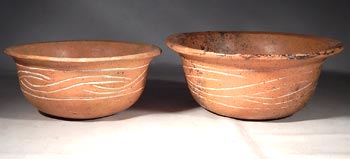 |
 |
Teotihuacan Orangeware Bowls — Mexico
400 AD - 650 AD
Two orangeware pottery bowls from Teotihuacan, Mexico. Both with similar designs of curved linear incising embedded with white stucco.
Condition is fair to good. Each assembled from 5-6 original pieces with breaks restored and small losses replaced. Heavier deposits on the larger bowl.
Ex. J. Magor collection of Chicago, IL. Collected mid-1960s. Approx. 5" x 2" and 6.25" x 2.5"
$250 for both bowls.
|
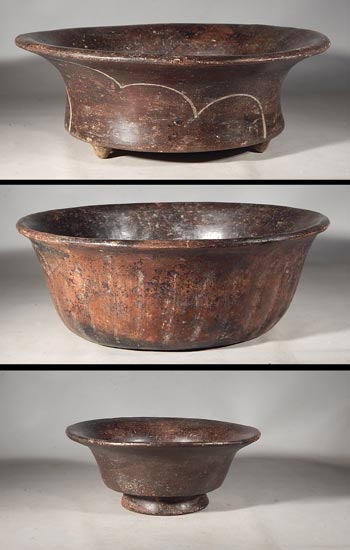 |
 |
Teotihuacan Brownware Bowls — Mexico
400 AD - 650 AD
Three pottery bowls from Teotihuacan, Mexico. All are brownware terracotta and are nicely burnished. Colors vary from a rich chocolate brown to shades of dark oranges and blacks.
In good condition. Each has been assembled from several original pieces with breaks restored and small losses replaced. Minor surface wear, dings and scratches along with light deposits, all consistent with age.
Bowl #1 (Top), Large, shallow bowl with small nubbin tripod feet, widely flared sides and decorated with incised scalloped (cloud) designs. 8.5" across x 3" tall - $400
Bowl #2 (Center), Large bowl with flared rim and carved, fluted (ribs) pattern all around the exterior. 8" across x 3" tall - $300
Bowl #3 (Bottom), Small bowl that sits on a footed pedestal base and with gently flared sides. An elegant form. 5.25" across x 2" tall - $200
All are Ex. J. Magor collection of Chicago, Illinois. Originally collected in the mid-1960s.
Priced individually, or $750 for all three bowls.
|
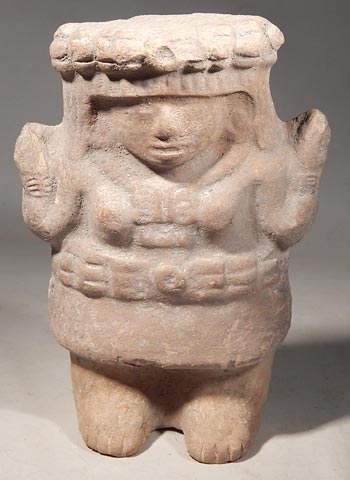 |
 |
Jaina Island - Maya Rattle Figure — Mexico
600 AD - 900 AD
A nice Classic Period Maya rattle figure from Jaina Island, gulf coast of Campeche, Mexico. A hollow-molded standing female figure with raised hands.
She is adorned with elaborate regalia; wearing a headdress, ear spools, necklace with large pendant and tunic (poncho) wrapped by a wide belt.
Buff terracotta construction with some white stucco remaining in the deep crevices and light earthen deposits overall. Inside the figure are numerous rattle balls.
Condition is very good. One foot partially restored and a few missing fingers (ancient losses) otherwise completely intact and original.
Similar examples can be seen in the book "Hidden Faces of the Maya" by Linda Schele.
Provenance: Ex. Fernandez Leventhal Gallery of New York City. Original Leventhal COA is also included. Ex. K. Godsoe collection of Canada.
Approx. 6" tall x 4" across.
$650
|
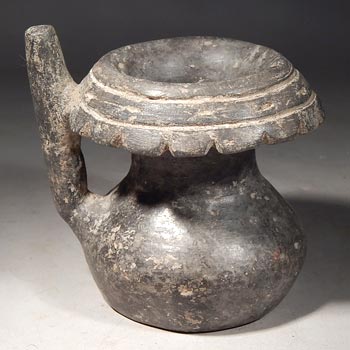 |
 |
Zapotec Miniature Vessel — Mexico
250 AD - 650 AD
A Pre-Classic (Phase I) Zapotec miniature vessel from the Monte Alban region of Central Mexico. Grayware terracotta with a nicely burnished surface.
Flat bottom with rounded body and tapered neck topped by a large inverted rim with incised decoration and a scalloped edge. A tall, faux spout handle on one side.
In good condition with some rim restoration and the tip of the handle restored, otherwise intact. Light to moderate deposits overall. There is a similar example of this type on display at the
Davis Museum and Cultural Center of Wellesley College in Massachusetts.
Ex. Lynn Langdon. Ex Hank Johnson. Ex G. Alderman.
Approx. 3" across x 3" tall.
$225
|
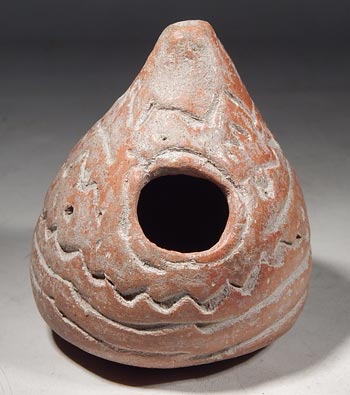 |
 |
Jalisco Beehive Vessel — West Mexico
100 BC - 250 AD
An unusual Pre-Classic Period redware vessel from the Jalisco region of Western Mexico. Somewhat pear-shaped and decorated with deeply incised dots, zig-zag and linear designs.
There is a large opening on the side and a small hole at the top. This type is typically referred to as a 'beehive' form, but their exact purpose is unknown. Could be a honey dipper or possibly a baby feeder,
but it also functions as a whiste. It will whistle loudly by blowing across the opening, much like one would 'play' a glass soda bottle.
The highly burnished orange-red surface shows calcified deposits and mineralization, heavy in some areas. In excellent condition with no cracks, breaks or chips.
A fine example of a very rare type.
Ex. Lynn Langdon. Ex Hank Johnson. Ex G. Alderman.
Approx. 3" across x 3" tall.
$250
|
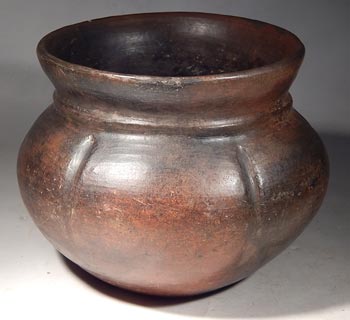 |
 |
Maya Brownware Squash Vessel — Guatemala
600 AD - 900 AD
A fine Maya sguash-form olla from the Tiquiste region of Guatemala, dating to the Classic Period. Rounded body with ribbed sides and a wide flared spout.
Nicely burnished brownware surface with light deposits inside and out. In near excellent condition. Two very small rim chips have been restored, otherwise
intact and original. Minor scrapes and dings consistent with age. A lovely example with elegant form and rich brown color.
Approx. 4.5" tall x 5" across.
$275
|
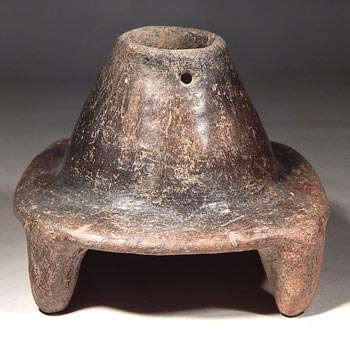 |
 |
Colima Incensario — West Mexico
250 BC - 250 AD
An early incensario from Colima, West Mexico. A four-legged platform with a hollow inverted cone on top. The unusual shape of these small incensarios are thought to represent an ancient pottery kiln or
possibly a volcano effigy. Two holes near the rim were used for suspension or to secure a lid. The blackware surface is nicely burnished and shows considerable deposits and root marks.
In near excellent condition. One leg reattached with the break restored. Minor rim chips restored along with some light erosion around the top.
A very rare form and seldom seen type.
Ex. Lynn Langdon - collected between the 1940s and early 1960s.
Approx. 3.5" x 3.5" across x 3" tall.
$250
|
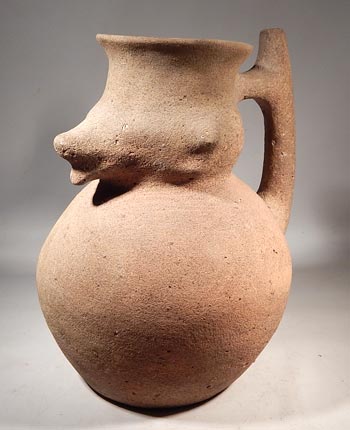 |
 |
Maya Coatimundi Vessel — Guatemala
250 BC - 250 AD
A large Maya pottery vessel from the Kaminaljuyu region of Guatemala, dating to the Pre-Classic Period. Nicely sculpted in the form of a stylized Coatimundi with rounded body and wide, flared opening at the top.
The tail on the back is hollow and served as a handle and pouring spout. The bottom is deeply concave. Coatimundi were called "chic" by the ancient Maya and are similar to the North American raccoon.
They are curious and mischievous animals that were kept as household pets by the Maya and are sometimes depicted in their art. This example is constructed of buff terracotta and is in very good condition.
A few restored cracks on the side and the top rim have been partially restored, otherwise it is intact and original. Very cute piece and is substantial in size.
Ex. private Texas collection.
Approx. 8.5" tall x 7" across.
$675
|
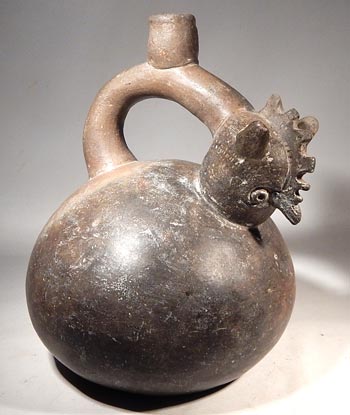 |
 |
Chavin Harpy Eagle Stirrup Vessel — Peru
800 BC - 400 BC
An early Chavin grayware terracotta stirrup vessel in the form of a Harpy Eagle. The rounded body is topped with the bird's head. It has a sharply pointed curved beak, pierced eyes and a central ridge of plumage.
Also has two raised ear-like tufts on either side of the center crest. A tapering stirrup handle with a short spout typical of the type and period. The lightly burnished gray surface has a large area of (almost black) fire-clouding.
Considerable light-colored mineralization overall, heavier in the deep crevices. In near excellent condition. One spike of the central plum and one ear tuft partially restored along with a single hairline crack
restored on the body of the vessel. A great example of early Chavin pottery.
Ex. Atlanta, Ga. private collection.
Approx. 9" tall x 6.5" across.
$850
|
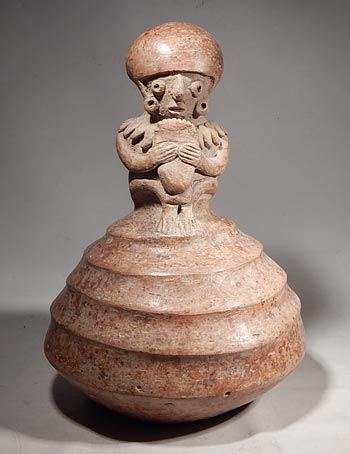 |
 |
Manteno Figural Vessel — Ecuador
1000 AD - 1500 AD
A fine Manteno figural vessel from Pre-Columbian Ecuador. Rounded lower chamber with a concentric (graduated) stepped form, topped by a seated figure playing a pan flute. The figure is nicely adorned
with ear spools and a wide pointed collar, likely representing feathers. He also wears a domed headdress and is holding a large pan flute. Burnished surface and ample deposits present. Condition is very good.
The figure has been reattached at the legs and the break restored. A single stress crack along the lower chamber has been stabilized and restored.
Minor repairs to several of the collar points; otherwise intact and original. Shows some light surface wear as would be expected. Overall a great example and a rare type.
Ex. R. Murray collection of Georgia.
See page 209, plate 122 of Klein and Cevallos "Ecuador - The Secret Art of Pre Columbian Ecuador" for a comparable example and additional scholarly information.
Approx. 9" tall x 6" across
SOLD
|
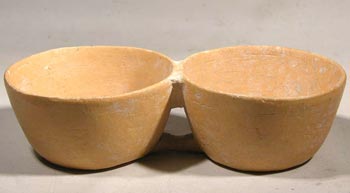 |
 |
Jama Coaque Conjoined Bowls — Ecuador
500 BC - 500 AD
A choice Jamacoaque pottery vessel featuring a matched pair of conjoined bowls. The bowls are attached at the rim and again at the base. Very well constructed and thin walled.
The surface is a lovely pale-orange slip and shows deposits and fine root marks. Condition is excellent. No cracks, breaks or repairs. A very rare type.
Approx 6.5" across x 1.5" tall.
$300
|
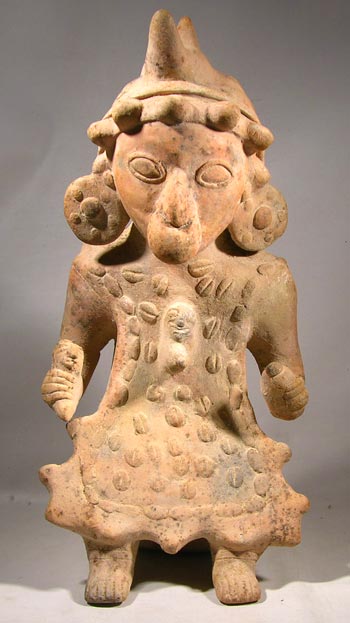 |
 |
Jama Coaque Seated Shaman Figure — Ecuador
500 BC - 500 AD
An exceptional Jamacoaque pottery figure of a seated Shaman. Heavily adorned; he wears an elaborate jewelry assemblage: a large spherical nose-piece, huge ear spools and a perctoral.
He is shown wearing a complex headdress with two-pronged horn on top, long side flaps down the back and cone-shaped nodes on the frontal ridge.
A long cape drapes from the shoulders to below the knees. The cape is decorated with oval appliques (possibly representing cocoa beans) and a pectoral featuring a human face carved into a curved horn.
In one hand he holds a lime dipper (spatula) also having a human face; in the other he holds a lidded "poporo" (lime pot). The lime pot and dipper would have been used for the ingestion of Coca
or other hallucinogenic substances. The practice of inhaling hallucinogens was critical to the shamans of Pre-Columbian times. It enabled them to induce shamanic trances and visions.
During such altered states of consciousness, shamans would communicate with spiritual beings as well as the deceased, and travel on shamanic journeys in the supernatural realm.
Large figures of shamans, such as this one, are indicative of their high status in Jamacoaque culture and are often depicted displaying their ceremonial paraphernalia as symbols of power.
Constructed of tan terracotta with orange pigment on the face and nose ornament. Faint traces of other colors remaining in some areas. Condition is very good, near chioce with only very minor repairs and replacements.
Two fingers and a portion of the strap across the head have been replaced. One foot has been reattached and the break restored. A few small cracks have been stabilized and restored.
Overall it is intact and original. Considerable dendrites and other deposits present throughout. A very fine and unusual example that displays impressively!
Approx 10.5" tall x 5" across.
$3250
|
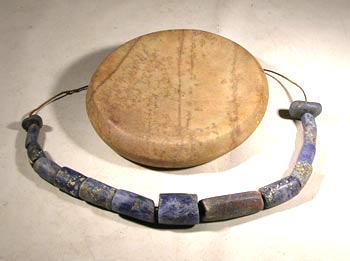 |
 |
Chavin Stone Mortar and Beads — Peru
900 BC - 500 BC
Early stone items from the Chavin culture of Northern Peru. A shallow stone dish, nicely carved and in excellent condition. "Mortars" such as this are thought to have been used to grind pigments or medicinal herbs and roots.
A very rare item. Along with a strand of fifteen sodalite tubular and disk shaped beads. Most have deposits, a few are chipped, some with red cinnabar, but generally intact and near choice.
Mortar is approx 4" across x 1" tall. - $500
Sodalite beads strand approx. 9" long. - SOLD
|
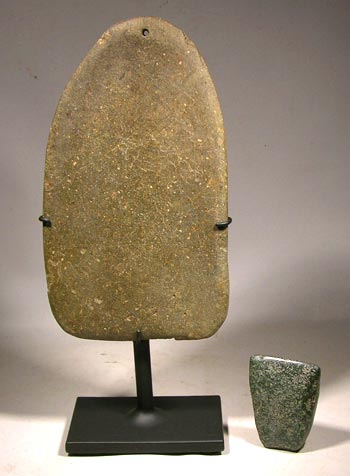 |
 |
Maya Stone Pendant and Celt — Guatemala - Honduras
600 AD - 900 AD
Very large Maya stone pendant dating to the Classic Period. Nicely carved from a greenish-gray stone in the form of a celt.
A small hole drilled near the top for suspension. In very good condition. Restoration to a small area of the lower corner, else intact.
A few edge chips along with minor scrapes and dings, but overall a nice example and rarely seen in this size.
Displays well on custom metal stand which is included as shown.
Included is a small, but lovely Maya stone celt, also from the Classic Period. Carved from a dark blueish-green hardstone. Fine quality and in
near excellent condition. A few imperfections but shows nice deposits and has a sharp chiseled edge.
Ex. Collection of Bernard and Bernadette Lueck, Founders of the Heritage of the Americas Museum in El Cajon, California.
Pendant - Approx 6" tall x 3.5" across x .25" thick. Over 8" tall on stand.
Celt - 1.75" long x 1.25" across x 3/8" thick
$475 for both
|
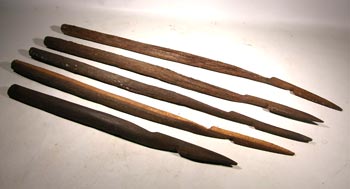 |
 |
Chancay Harpoon Points — Peru
1100 AD - 1450 AD
A collection of five Chancay harpoon points. These wooden barbed points would have been lashed to longer shafts and were most likely used for fishing in the rivers and coastal waters.
All in very good condition. Two points have a glued break. The others are intact. All show wear with some cracking and splintering consistent with age. Very rare items!
Sizes range from approx. 12" long to 16" long
$75 each or $300 for all five
|
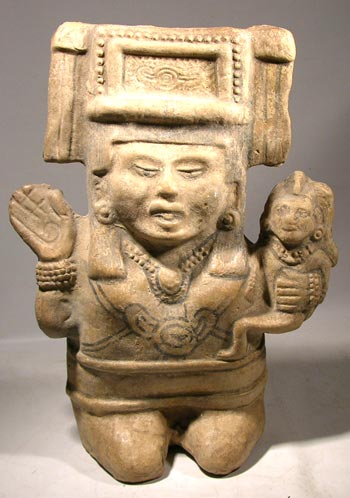 |
 |
Veracruz Nopiloa Maternal Figure — Mexico
600 AD - 900 AD
Published Veracruz Nopiloa maternal figure dating to the Late Classic Period. Buff terracotta kneeling mother holding a child. She wears an elaborate headdress along with beaded necklace and bracelets.
Black painted decoration on the headdress and body. Her teeth are filed as is common. The figure contains numerous rattle balls and a whistle in the base.
The whistle works, but not well. Condition is very good. The corner of the headdress is chipped. Several breaks across the body have been restored, but it is all
original and appears near choice. Ample deposits and areas of wear as would be expected. A fine and rare example with excellent published provenance.
NOTE: This exceptional artifact is featured in the well known (1968 - Abrams) book "Pre-Columbian Art of Mexico and Central America" by noted author, Hasso Von Winning. See page 203. Image 265.
Approx 9" tall x 6.5" across
$7500
|
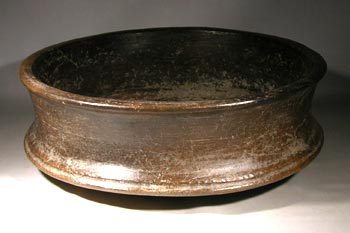 |
 |
Large Chupicuaro Bowl — Mexico
500 BC - 100 BC
A lovely Chupicuaro brownware pottery bowl. The low, wide bowl has a slightly rounded bottom, deeply corseted sides, and a stepped lower edge with impressed rope design.
The nicely burnished chocolate brown surface shows light mineral deposits and considerable root marks inside and out. Excellent condition, one tiny rim chip, else intact and choice.
A large example with an elegant form that displays beautifully.
Approx 11" across x 3" tall
$475
|
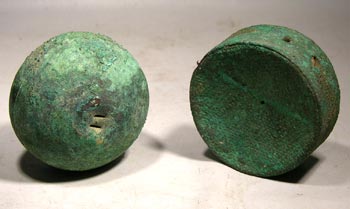 |
 |
Moche Copper Rattles — Peru
300 AD - 600 AD
Two rare Moche rattles; one spherical, the other cylindrical. Hollow copper with rattle balls inside. Each is pierced for suspension and were likely worn as pendants or clothing ornamentation.
Both have a heavily oxidized surface as would be expected. Intact and their condition is excellent. Fine examples!
Each approx. 2" across
$225 each or $400 for both
|
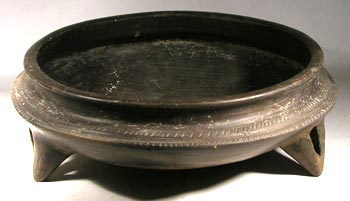 |
 |
Chupicuaro Tripod Vessel — Mexico
500 BC - 100 BC
A lovely Chupicuaro blackware vessel. The low, wide bowl has a stepped edge with two rows of incising all around supported by three pointed hollow legs.
The burnished blackware surface shows light mineral and earthen deposits. Near excellent condition with restoration to one leg; else intact and choice.
A large example with an elegant form that displays beautifully.
Just under 9" across x 3" tall
$750
|
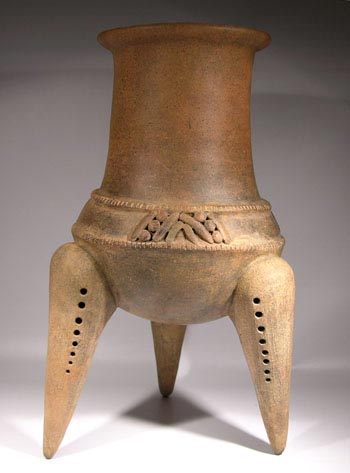 |
 |
Large Tripod Rattle Vessel — Costa Rica
400 AD - 700 AD
Very large Costa Rican tripod rattle vessel from the Central Highlands - Atlantic Watershed Zone, dating to Period IV-V.
It has pierced tapered tripod legs, each containing numerous small rattle balls.
The legs support a semi-hemispherical bowl with curving shoulder that is decorated with appliques and incised bands, topped by tall chimney-type neck and flared spout.
Faint remains of white pigment on the legs and traces of black on body of the vessel. Condition is fair to good. Restored breaks to the legs as is common.
A large section of the neck has been replaced along with other repairs and surface touch ups. Overall an impressive piece that displays dramatically. Rare for its large size.
See page 62 of the "Art of Costa Rica from the Arthur M. Sackler Collections" for a similar example and additional information.
Approx 13.5" tall x 7" across
$600
|
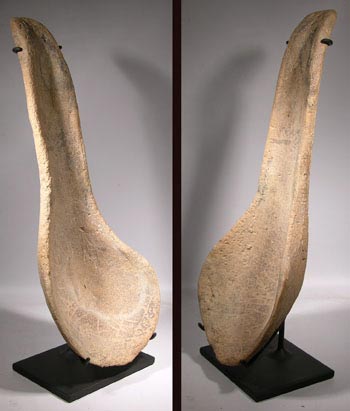 |
 |
Vera Cruz Spoon — Mexico
600 AD - 900 AD
Large Vera Cruz pottery spoon or ladle. Undecorated buff terracotta with heavy deposits, root marks and light staining. Overall in good condition. The handle was broken in two places. The breaks have been restored,
along with the tip of the handle and two areas of the spoon's rim. General surface wear and some edge erosion as would be expected. A rare example of an ancient utilitarian item.
Custom display stand is included.
Approx. 12" long x 4.5" wide
$300
|
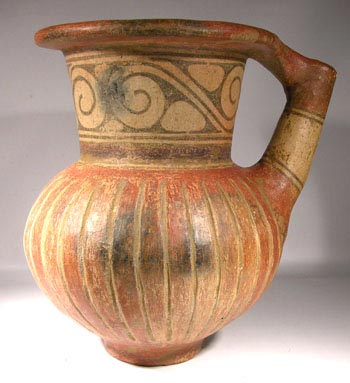 |
 |
Large Cocle Filtro — Panama
600 AD - 800 AD
Unusually large Cocle dual-spouted vessel. The main body is vegiform; rounded and carved with vertical incising, likely representing a squash.
The neck is wide and beautifully painted in a scroll pattern. The vessel's design is often referred to as a "Filtro". It is thought
that vessels of this type were used in water worship rituals. This dual-spout design appears to incorporate dimorphic symbolism with the long, tapered
"male" spout being intentionally connected to the wider "female" spout. Condition is near excellent with general surface wear and minor paint
loss consistent with age. A few small areas of fire-clouding. The handle-spout has been reattached and poorly repaired. The breaks could be properly
restored at minimal additional cost. Overall a fine example.
See Labbe's "Guardians of the Life Stream" for additional info.
Approx. 8" tall x 7" across
$950
|
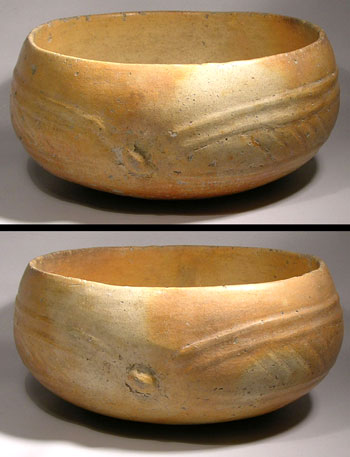 |
 |
Maya Bowl — Guatemala
200 AD - 600 AD
Shallow orange-creamware bowl from the Southern Lowlands of Guatemala. Thin-walled construction decorated with nodes, one on each side. Tthe nodes are connected by gently curving raised horizontal lines along with recessed diagonal lines. Condition is generally fair to good. Assembled from three large original pieces with restored breaks. Areas of spalling (surface pitting), mainly on the underside, do not detract from its appearance. Overall an attractive example of the type and somewhat rare. Nice deposits.
Approx 6" across x 3 tall
$275
|
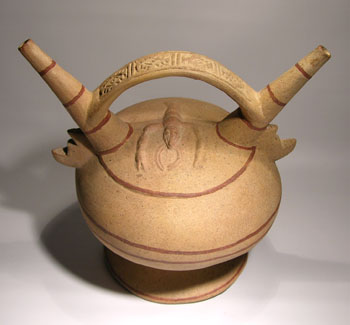 |
 |
Lambayeque Lobster Vessel — Peru
700 AD - 1150 AD
Attractive Lambayeque double-spout vessel in buff terracotta. Round body with a nicely detailed lobster on top. Flared footed base, tapered spouts connected by a arched handle.
The handle is divided into four panels each decorated with finely carved geomectric patterns. Two styilzed faces adorn
each side just below the spouts. Reddish brown rings are painted around the base, body and spouts. Overall in fair to good condition. Assembled from several original pieces with
restored breaks and paint touch ups, but appears choice. An elegant form. Pretty!
Approx 7" across x 7" tall
$500
|
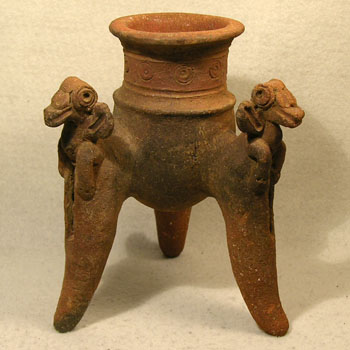 |
 |
Costa Rican "La Selva" Tripod — Costa Rica
400 AD - 700 AD
Beautiful Period IV La Selva tripod vessel from the Atlantic Watershed region of Costa Rica. Three gently curving hollow legs, each containing rattles.
Atop each leg are zoomorphic figures. The bowl is elongated with a corseted neck decorated and a row of incised circles. Very elegant in form and proportion.
In generally good to very good condition. A few repairs as is common. Two of the legs have been reattached with restored breaks. Other minor repairs.
Some surface erosion, mainly on the lower legs, but overall a nice and attractive example.
Note: See Paul Clifford's "Art of Costa Rica" from the Arthur M. Sackler Collection pages 224-227 for similar examples of the type and additional information.
Approx. 7.5" tall x 5.5" across
$550
|
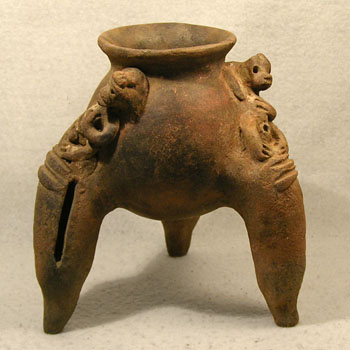 |
 |
Costa Rican Tripod Vessel — Costa Rica
400 AD - 700 AD
Costa Rican tripod rattle vessel dating to the late Phase IV period into early Phase V. These are sometimes referred to as "spider-leg vessels" or "chocolate pots".
Round-bodied vessel supported by three hollow legs. Each leg contains three rattle-balls.
Atop each leg are well sculpted and finely detailed monkey figures whimsically leaning to one side. A nice example in good condition. Several repaired breaks as is common. Two of the three legs have repairs with the rattles of one leg replaced.
A few rim chips have also been restored. Some minor chips remain. Appears near choice and displays beautifully.
Note: See Paul Clifford's "Art of Costa Rica" from the Arthur M. Sackler Collection for similar examples and additional information.
Approx. 6" tall x 5.5" across
$325
|
Shipibo Pottery
New Shipibo Pottery Page
The Shipibo items have been relocated. A new page dedicated to Shipibo pottery has been added to this website. To view these items, see the Shipibo Artifax page.
home | galleries > pre-columbian > colonial > shipibo > african > asian > classical > pacific rim | restoration services | display stands | about | contact
© 2025 Ancient Artifax LLC. All Rights Reserved. joey@ancientartifax.com
|















































































